Bathrooms are arguably the wettest location in a house. To prevent moisture damage, it is important to adopt an appropriate method of removing moisture and humidity from the room.
One of the key functions of bathroom exhaust fans is to remove moisture from the room. However, ductless bathroom fans aren’t designed to function like normal bathroom fans. Read on to find out how ductless bathroom fans work and whether they can remove moisture from a room.

Ductless bathroom fans are incapable of removing moisture. The lack of ducting means that they cannot transfer moist air out of the bathroom. They function to remove odors, etc., using a carbon filter, but this filter cannot trap water droplets, so the air released back into the bathroom is still moist.
Ductless Bathroom Fans Don’t Remove Moisture
As its name infers, a ductless fan doesn’t feature a duct. Although this has its advantages, especially in locations where venting the fan outdoors is difficult or impossible, it also has its drawbacks.
In place of a duct, ductless fans are outfitted with an activated charcoal filter.
Activated charcoal filters, otherwise referred to as carbon filters, are popular in different industries for their natural cleansing properties.
However, compared to a duct, the abilities of an activated charcoal filter are limited. In some respects, I would even say that you cannot compare them; they are like chalk and cheese.
Although they help to rid the air of impurities like odors, VOCs, and other gaseous pollutants, they can’t do anything about moisture or humidity.
Neither the filter nor the fan itself (there is no built-in dehumidifier) is designed to absorb or remove moisture, so if you need a fan for this purpose, a ductless bathroom fan isn’t the right fit for you.
Ventilation Not Achieved With Ductless Fan
The levels of moisture that are generated on a daily basis in a bathroom have necessitated ventilation. In fact, they are required by code to have a functional method of ventilation.
This could either be an operable window or a mechanical method, like an exhaust fan.
In simple terms, ventilation involves the removal of “old” or contaminated air from an indoor space and replacing it with “new” or clean air from an outside location. In bathrooms, this means that the ventilation system needs to remove moist air and replace it with dry air.
For this to occur, there has to be a medium for interaction between the room and the outdoors.
With ducted exhaust fans, humid air is expelled from the bathroom through the duct.
Ductless bathroom fans do not have a duct, so all their activities occur within the fan. This makes it impossible for them to ventilate a space (they are not up to code for this function).
Rather than ventilate the room, with the help of an activated charcoal filter, ductless fans rid the air of gaseous impurities and odors and then recirculate the filtered air into the room.
This means that they recirculated stale, albeit filtered air back into the room.
Problems With Poor Bathroom Ventilation
Improper ventilation means that humid air wouldn’t be removed from the space, causing humidity to be trapped in the bathroom.
Humidity can lead to issues, especially for homeowners who love taking steamy showers.

Here are some effects of high humidity levels:
- Growth of mold and mildew.
- The bathroom becomes a breeding ground for bacteria.
- Provides a conducive living environment for bugs.
- Humid air would eventually spread to other parts of the house, which would lead to an increase in energy bills as you add devices to remove humidity from these rooms or try to cool them down.
- Damaged bathroom furniture and fixtures.
- Poor indoor temperature control.
- Peeling and fading paint.
- Warped wooden fixtures.
- Misty mirrors.
- After a prolonged period, it can affect the structural integrity of the house.
Removing Moisture From a Bathroom Without a Fan
Although exhaust fans are a great way to remove moisture from a bathroom, they are not the only option available to homeowners.
Here are other methods of removing moisture from your bathroom if you are unable to install a ducted bathroom fan.
- Install a dehumidifier (amazon link).
- Use moisture-absorbing crystals (amazon link).
- Open the windows. If you can’t leave them open at all times, ensure that they are open during and at least 20 minutes after taking a shower.
- Leave the bathroom door open while you’re in the shower. If that isn’t possible, leave it open for 15-30 minutes after you are done.
- If the kitchen is close to the bathroom, run the range hood while the door is open.
- Run your whole house ventilation system while the door is open.
- Install a door vent. This would allow air to move in and out of the bathroom.
- Add plants to the bathroom. Certain plants like peace lily, spider plants, Boston ferns, and snake plants are great at absorbing moisture from the air.
Tips to Reduce Moisture in Bathroom

- Manually wipe moisture from walls, floors, and mirrors.
- Install a shower dome.
- Clean spills and splatters as soon as you notice them.
- Dry towels outside the bathroom.
- Take shorter and cooler showers.
- Use a shower curtain.
Sources
https://www.sobieskiinc.com/blog/everything-you-should-know-about-bathroom-ventilation/
https://www.hunker.com/12470260/how-to-dehumidify-a-bathroom-without-an-exhaust-fan
https://homeinspectorsecrets.com/bathroom-exhaust-fans/best-ventless-bathroom-fan/

